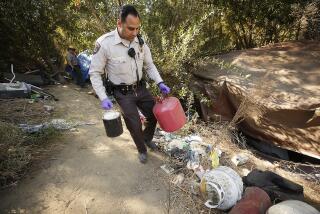Park Ranger’s Firepower Has Gone From Zero to .357 in a Short Time
- Share via
SANTA ANA — As he patrols the city’s 38 parks and playgrounds, Park Ranger Ken Poole strides a little more confidently these days.
His job is the same as it was a year ago--assisting visitors and providing security at city parks while searching for vandals, burglars, drug users or others committing minor infractions, such as drinking beer.
But what has changed is Poole’s ability to defend himself.
Since February, the park ranger supervisor has been packing a .357 Smith & Wesson revolver.
Poole has yet to draw the gun, and he hopes he never has to.
“One time, this guy dropped a big, big knife on me,” Poole said. “I never used (the gun). I forgot I had it. I’m not used to having it.”
Santa Ana became the first Orange County city to arm its park rangers when it approved the program 13 months ago. The intention, officials said, was not to create a new police force but to place the park rangers on a level with the troublemakers who make the rangers’ jobs hazardous.
Before then, rangers were authorized to wear bulletproof vests and carry batons, Mace and two-way radios.
“If the rangers are armed, the people who take the shots might not take that shot if something is flying back at them,” said Rip Ribble, assistant director of the Recreation and Community Services Department.
The weapon, Ribble added, “is not to be used unless it’s a life-threatening situation.”
Poole, who has been a park ranger for 10 years, said incidents that “appear to have a high likelihood of violence or death” will continue to be handled by police.
“But it’s nice to know that if I am in a situation I cannot get out of, and I am suddenly under a violent attack, I can come back on a parallel level,” he said.
Because of staff turnover and the extra training--including psychological testing--required of rangers before they can carry firearms, Poole has been the only one on the five-member, full-time park ranger force to carry a gun. Two newly hired park rangers, expected to come on duty at the end of this month, also will be armed.
Although the program has been in place only since February, the fact that Poole’s weapon has not been used is testimony to its effectiveness as a deterrent, Ribble said.
“There are situations, that sometimes by having a weapon on your hip, you tend to be observed as having more authority,” Ribble said. But he added that the rangers also must be careful not to have a false sense of security.
John Chapman, chairman of the city’s Recreation and Community Advisory Board, said citizens have reacted positively and told him that arming the rangers was “long past due.”
During a visit to a local park recently, Chapman said he spoke to two joggers who watched a park ranger take an alcoholic beverage from a group of men and pour it on the ground.
“They were wondering if he was going to be able to do that and walk away without getting hurt,” Chapman said.
City officials also are quick to point out that in most cases, neighborhood parks are not as dangerous as the public perceives. They say that so far this year, there has been only one shooting in a city park and it was gang-related.
“Whenever gangs start moving in, there’s a tendency for the park users to move out of the park,” Ribble said. “That’s the worst thing that can happen. As soon as we see graffiti, we try to get it removed as fast as possible. As soon as we see gang activity, we try to remove them as fast as possible.”
Poole said that having a gun has not changed the way he does his job, but he knows it makes a difference with the citizens with whom he deals.
“It makes them feel that now the city is getting more serious about trying to keep the parks safe,” he said.
More to Read
Sign up for Essential California
The most important California stories and recommendations in your inbox every morning.
You may occasionally receive promotional content from the Los Angeles Times.










